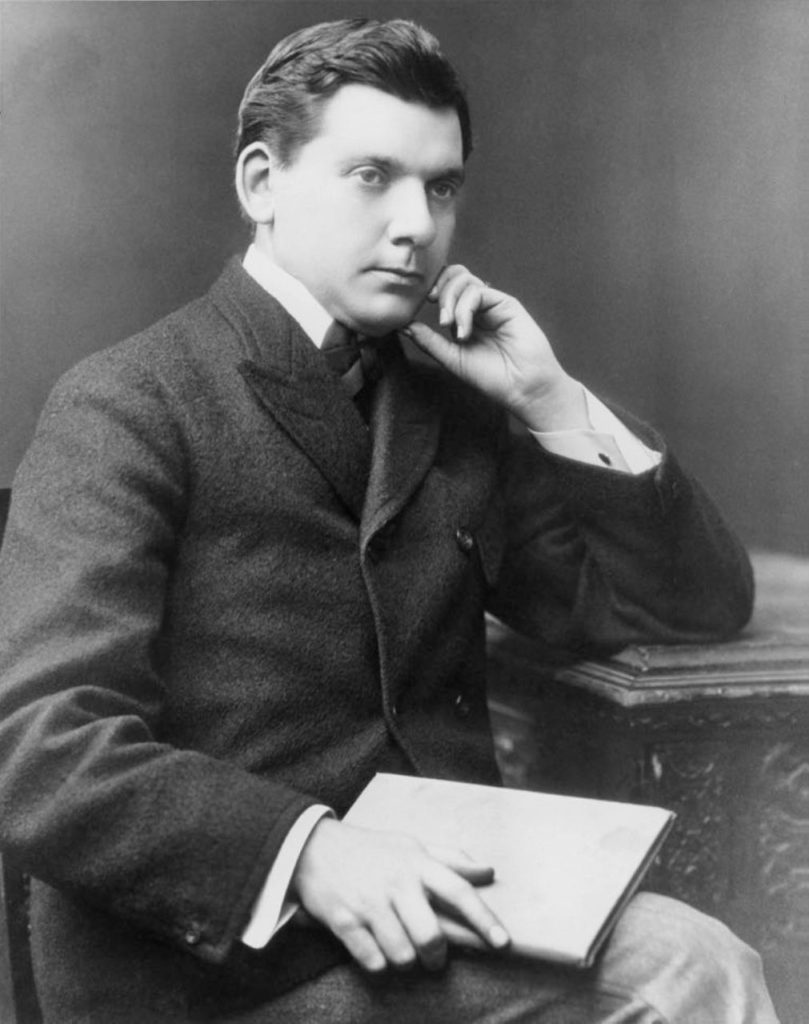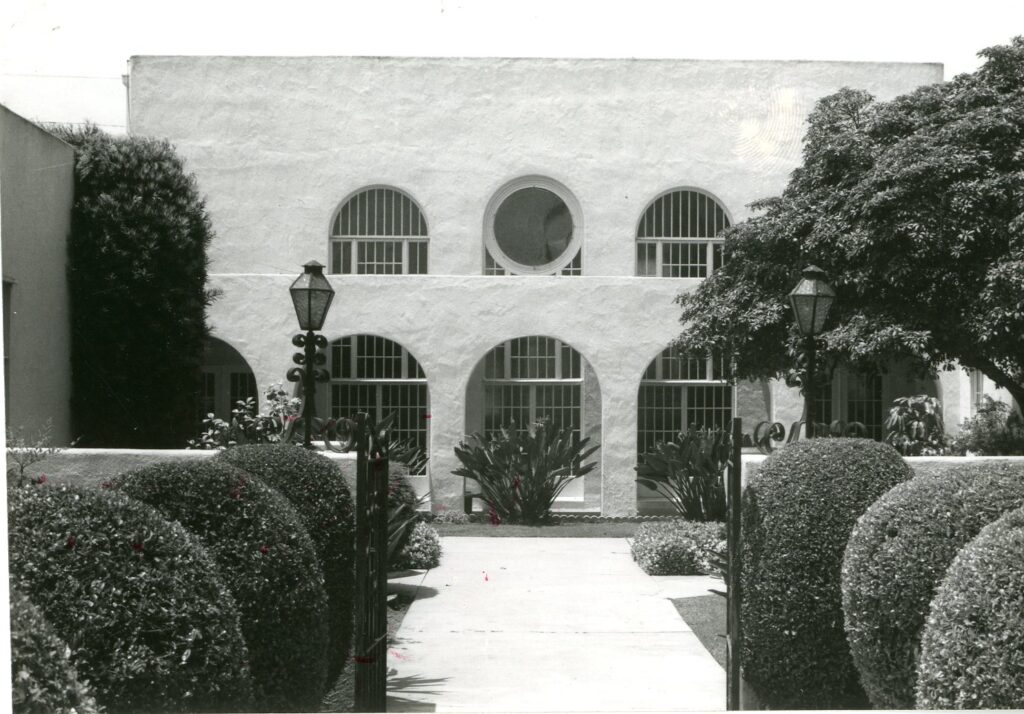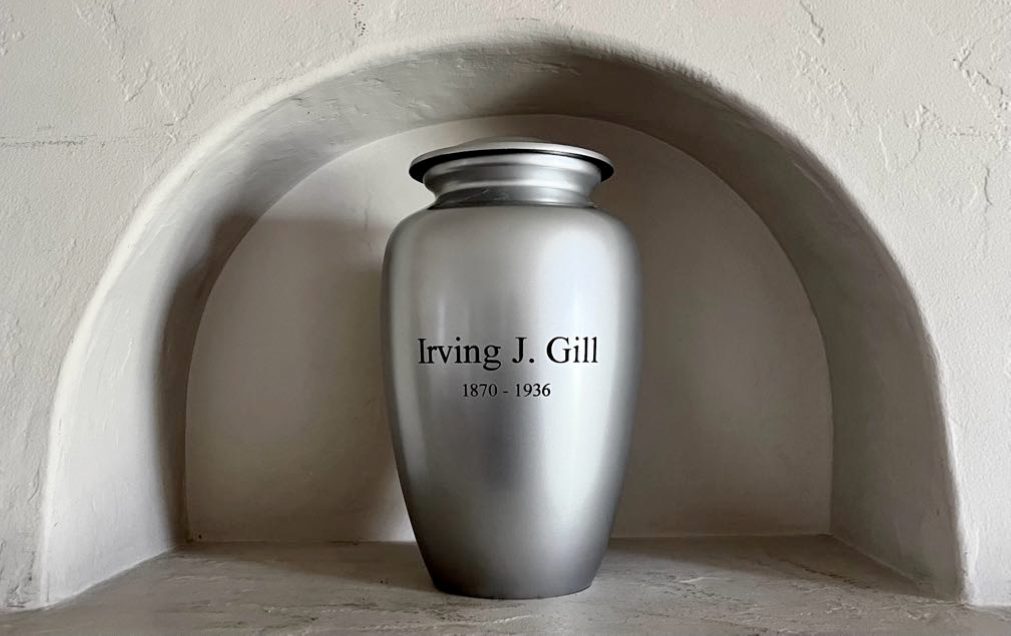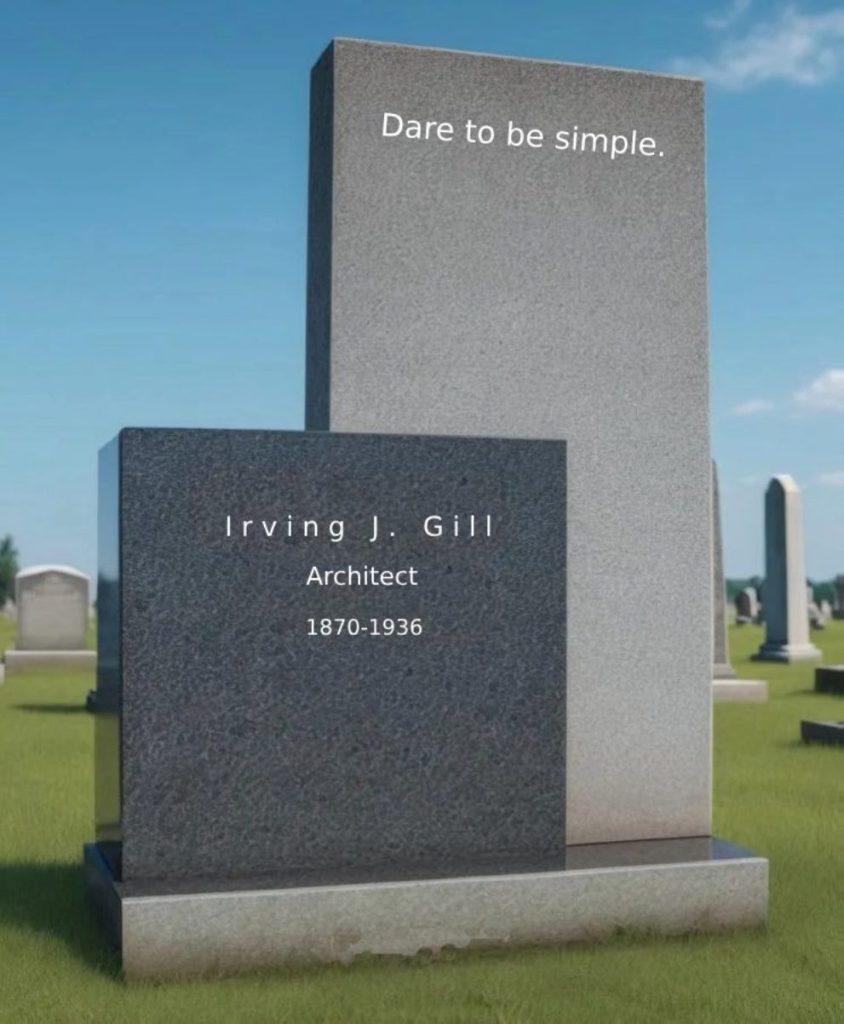
Photographer unknown.
Irving J. Gill passed away in 1936, though his ashes have only recently been discovered.
Irving John Gill was born in Tully, New York, in 1870. His journey in architecture took him from Syracuse to Chicago, San Diego to Los Angeles and back again. His innovative designs laid the foundation for Modern architecture in Southern California and beyond. Gill spent his final years managing his and his wife’s ranch in Carlsbad, California, where he continued working on architectural projects until his death on October 7, 1936.

According to the Coronado Historical Association in advance of a 2022 lecture,
Gill’s signature style developed and shined in his structures built in Coronado. From the time of his partnership with William Sterling Hebbard, Gill worked on almost 20 buildings in Coronado. The first to contract Hebbard & Gill was Harry W. Nichols in 1895 to design his home. From 1898 to 1902, Hebbard & Gill designed & built several other homes, including 1300 Orange Avenue (now relocated); 711 and 723 A Avenue for Anson P. Stephens; 1517 Ynez Place; 1135 Loma Avenue; and 1015 Ocean Boulevard.
In 1910, Gill independently designed and built 1156 Isabella Avenue and 1007 Ocean Boulevard. These homes showcase Gill’s transition away from the American Arts & Crafts movement to his mature simplicity and stark signature. Gill’s commissions took off.
Today, structures attributed to Gill remain as lasting architectural legacies around Coronado. Irving Gill certainly left his mark in Coronado residential homes, but he also was involved in some of Coronado’s enduring sacred architecture.
Despite a storied career, the end of Gill’s life, long a mystery, has now been solved. After a serious heart attack on October 7, he was transported to San Diego Hospital in Hillcrest, where he passed away later that day. He was cremated the next day and his ashes were placed in a temporary cardboard box at Cypress View Mortuary, just minutes southeast of downtown, marked “Hold” for a family member to retrieve.
For decades, his remains were believed to have been scattered by his wife, Marion, according to a narrative popularized by the late historian and Gill biographer Bruce Kamerling. However, in 2022 it was discovered that the architect’s ashes had remained at Cypress View all along. After an exhaustive search for descendants proved unsuccessful, the Irving J. Gill Foundation petitioned the County of San Diego to release his remains, and the request was granted.

Photograph by Irving J. Gill FoundaZon

Design by Irving J. Gill Foundation
The Irving J. Gill Foundation has arranged a plot for his burial in Mt. Hope cemetery. The public is welcome to attend and pay their respects and to help honor a man whose vision continues to shape the form, light, shadows, and spirit of meaningful buildings and places.
Monday, October 7, 2024 from 2 to 2:30pm
Mt. Hope Cemetery, San Diego
Donations to the Irving J. Gill Foundation for Mr. Gill’s headstone are appreciated.
Learn more about Irving J. Gill’s work in Coronado.
The History of the Death and Final Disposition of Irving J. Gill
Irving J. Gill was born in rural Tully, New York, in 1870. At a very young age, the Gill family moved to nearby Syracuse, where he was raised. Ever curious and entirely focused on architecture, at only 19, his creative energy took him first to Chicago and then to San Diego and Los Angeles. As his career grew, he would take some professional side journeys to San Francisco and New England. His last days, amid the Great Depression, were spent in Carlsbad, California, on his and his wife Marion’s ranch, managing their avocado crops and working on what would be his final architectural projects.
Gill had at least one heart attack in the years before his last day, though he probably had more. We know he was also suffering from angina in the months leading up to his death, as there are letters by Gill to his wife about his pain.
At some point during the day of October 7, 1936, he suffered another serious, though at first, non-fatal heart attack. At the time of this heart attack, he was on their property in Carlsbad. We don’t know who he was with, but we can presume he was transported quickly to the San Diego Hospital in Hillcrest, San Diego, as he was alive when he arrived. We also don’t know why he traveled all the way to Hillcrest from Carlsbad, a thirty-mile trip. For example, the Scripps Hospital in La Jolla would have been a little closer.
He was conscious when he was admitted to the hospital. We do not know what friends or family members might have been there, but his nephew Louis’s home was no more than a mile away. His wife was likely at their primary home in Palos Verdes, ninety miles north of Carlsbad, 120 miles north of the hospital.
Gill’s heart ultimately failed, and he died later that same day. That day, or the next, his body was transferred to Cypress View Mortuary, also in San Diego. He was then cremated on October 8, 1936. To be cremated so quickly after death, we can presume that it was at the direction of the family, though there is no record of who gave this instruction. It is fair to assume that Marion was involved in this decision-making, even though she was not likely in San Diego at that time.
Gill’s ashes were placed in a temporary cardboard box with a typed label. A handwritten note on the side of the box said, “Hold.” The box was placed on a storage shelf at the mortuary, awaiting a family member’s retrieval.
Time passed; a lot of time.
In the 1980s or early 1990s, while Bruce Kamerling was researching his book on Gill (published in 1993), he was told a story, presumably by a descendant of nephew Louis Gill (1885-1969), that someone had given Gill’s ashes to Marion and that she scattered them. Kamerling was the first historian to write about Gill’s remains. Other historians would repeat Kamerling’s narrative. More time passed.
Around 2021, volunteers from the Find-a-Grave website (findagrave.com) went to the historic Cypress View mausoleum in San Diego and documented the paper records of the permanent and temporary interned. There were many. In mid-2022, a Gill aficionado was looking for Gill’s gravesite on the Find-a-Grave website. He found the recently added record that indicated Gill’s ashes were at Cypress View. He contacted the Irving J. Gill Foundation for more information. That Gill’s ashes where at Cypress View was news to IJGF as, like others, we had believed the Kamerling narrative. Naturally, we followed up with Cypress View and confirmed that Gill’s ashes were indeed in their possession and had been since 1936. They also confirmed that they were still in the original temporary cardboard box, still on a shelf in a closet, and still being “held” awaiting a family member’s retrieval. We were shocked at this revelation.
We inquired what it would take to provide Mr. Gill with a final and respectful disposition. We were informed that, without legal permission, they could only give the remains to a descendant. If there were no descendants, then we would have to follow a legal process to have the ashes released to our custody. We attempted to find a living descendent but were unable to. We then petitioned the County of San Diego to release the ashes to our care. The County acknowledged the request’s rarity and began their own search for a relative. They, too, were unable to find a descendent. They eventually granted our petition. We then acquired a burial plot for Mr. Gill in Mt. Hope Cemetery. Mt. Hope is San Diego’s historic cemetery where many of his friends, associates, and clients are also buried.
We plan to have a proper burial and graveside ceremony for Mr. Gill in October 2024. The Rev. Dr. Mark Hargreaves, rector at St James by the Sea, La Jolla, has agreed to preside over this ceremony. Gill designed the original St. James church, which has since been replaced by the current and larger church designed by his nephew Louis Gill. Rev. Hargreaves is also the author of our recent publication, The Sacred Architecture of Irving J. Gill.
James B. Guthrie, President
Irving J. Gill Foundation




